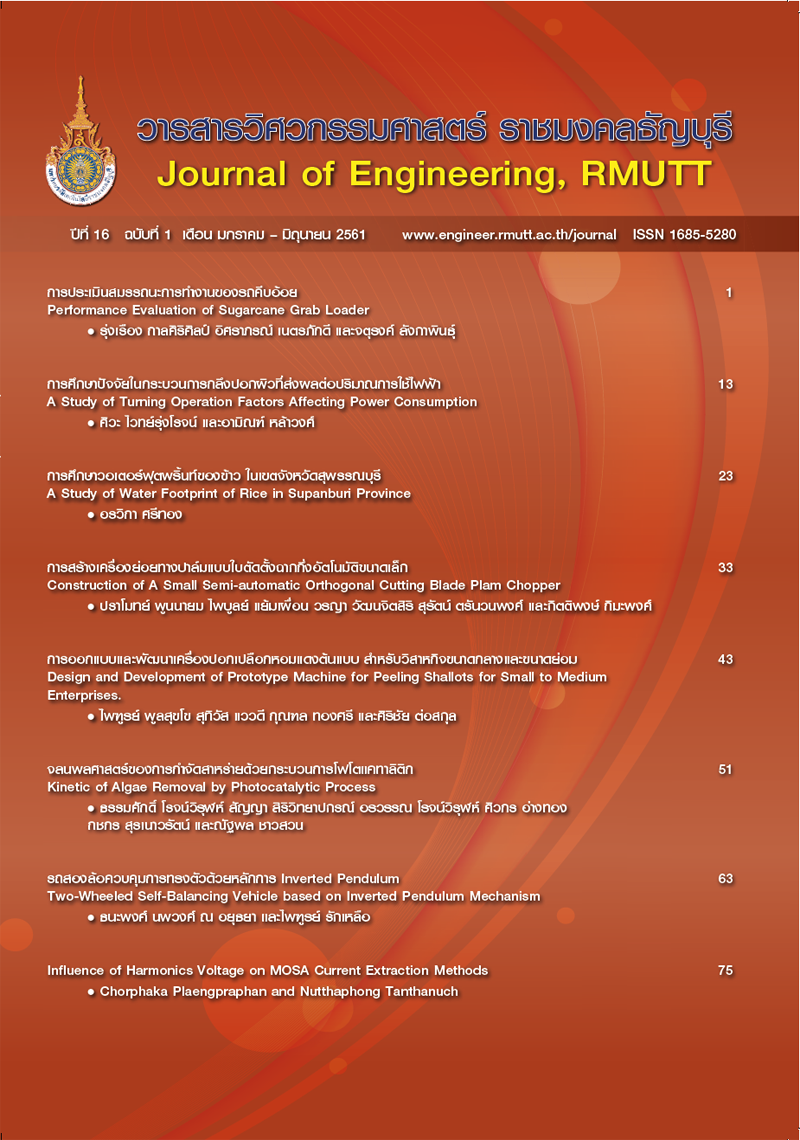Two-Wheeled Self-Balancing Vehicle based on Inverted Pendulum Mechanism
Main Article Content
Abstract
This article presents Two-wheeled self-balancing vehicle based on inverted pendulum, which has high sensitivity and stability using dynamic sensor, gyroscope, and static sensor, accelerometer to determine tilt angle of moving situation and staying situation, respectively. Both tilt angle sensors of proposed vehicle are controlled via Arduino board. The Arduino board gets a changing tilt angle of two-wheeled self-balancing vehicle from RATE Gyroscope and Accelerometer in order to analyse signal to drive motor for self-balancing and movement of proposed vehicle. In term of measurement procedure, the measured output signal results of RATE Gyroscope is linearly direct variation with angular velocity. Furthermore, the accelerometer’s output signal results is non-linearly direct variation compared with tilt angle of two-wheeled self-balancing vehicle. Practically, the proposed two-wheeled vehicle is examined balancing test depending on external force. When the external force is not exist, proposed two-wheeled self-balancing vehicle stays still at balance position. In other way, when the proposed vehicle is executed by the external force execute, the proposed vehicle becomes tilt from balancing axis cause both sensors detect tilt angle and sent the output signal to Arduino board to drive motor of proposed two-wheeled vehicle for being balancing position again. Finally, Two-wheeled self-balancing vehicle based on inverted pendulum offer low-cost, low-profiles and light-weight alternatives to commercially two-wheeled vehicle and also suitable use as a personal vehicle presently.
Article Details
The manuscript, information, content, picture and so forth which were published on Frontiers in engineering innovation research has been a copyright of this journal only. There is not allow anyone or any organize to duplicate all content or some document for unethical publication.
References
Deka products limited partnership, “Personal mobility vehicles and methods,” US Patent No. US6202230B1, 2001.
Larson, T. (2005), “Balancing robot project bender,”Lasta ccessedOctober 2005. [ออนไลน์] เข้าถึงได้จาก : http://www.tedlarson.com/robots/balancingbot.htm
Blackwell, T. (2005), “How to build a self balancing scooter,” Last accessed October 2005. [ออนไลน์] เข้าถึงได้จาก : http://tlb.org/scooter.html
David P. Anderson, “nBot Revision 6,” Last accessed September 2013. [ออนไลน์]
เข้าถึงได้จาก :http://www.geology.smu.edu/~dpa-www/robo/nbot/
Grasser, F., D’Arrigo, A., Colombi, S. and Rufer, A., “JOE: A Mobile, Inverted Pendulum”, Vol. 49, IEEE Transactions on Industrial Electronics, 2002.
A.-J. Baerveldt and R. Klang , “A low-cost and low-weight attitude estimation system for anautonomous helicopter,”Intelligent Engineering Systems conference, Sept. 1997.
เอกชัย กองเงิน, “การออกแบบแผ่นวงจรพิมพ์ ด้วย Protel 99 SE,” โรงเรียนแสงทองอิเล็กทรอนิกส์, 2546.
Intersil, “IC HIP4080AIPZ datasheet,” IntersilCooperation, [ออนไลน์] เข้าถึงได้จาก :https://www.verical.com/datashee t/intersil-gate-and-power-driver- hip4080aipz-112229.pdf
A. M. Bloch, D. E. Chang, N. E. Leonard, J. E. Marsden, “Controlled Lagrangians and the Stabilization of Mechanical Systems II: Potential Shaping, ” IEEE TRANS. ON AUTO. CONTROL, VOL. 46, NO. 10, OCTOBER, 2001, 1556–1571
STMicroelectronics co.Ltd., Rate Gyroscope LISY300AL datasheet, 2008.[ออนไลน์] เข้าถึงได้จาก : https://www.sparkfun.com/datasheets/ Sensors/LISY300AL.pdf
Analog Devices, Inc., Accelerometer ADXL 335 datasheet, 2009 [ออนไลน์] เข้าถึง ได้จาก :https://www.sparkfun.com/datasheets/Components/SMD/adxl335.pdf


